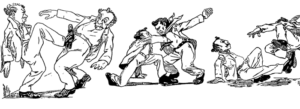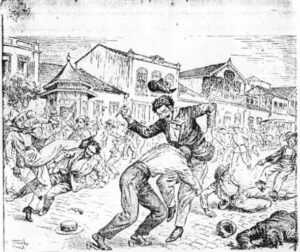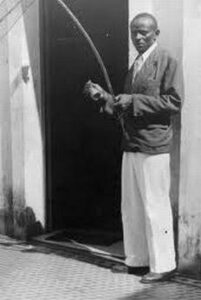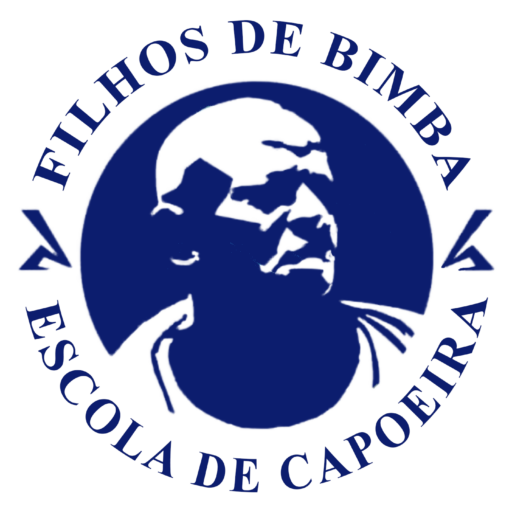 From 1680 to 1694, the Portuguese and Ganga Zumba’s nephew Zumbi, now the new king, waged an almost constant war. The final assault against Palmares occurred in January 1694. After the death of Zumbi and the fall of Quilombo dos Palmares, men, women and children were captured, resold and then shipped to various locations such as Bahia, and Rio de Janeiro. They would take with them memories of their fight named after the location in which it began its cultivation.
From 1680 to 1694, the Portuguese and Ganga Zumba’s nephew Zumbi, now the new king, waged an almost constant war. The final assault against Palmares occurred in January 1694. After the death of Zumbi and the fall of Quilombo dos Palmares, men, women and children were captured, resold and then shipped to various locations such as Bahia, and Rio de Janeiro. They would take with them memories of their fight named after the location in which it began its cultivation.
1789 marks the first documented evidence of capoeira: an arrest of a slave named Adam. On the charge of Capoeira, he was condemned to 500 lashes and two years hard labor in public service.
In 1830 a ban on drumming, batuques, dancing and shouting is enforced, along with curfews.
Slavery ended in the U.S. in the 1865, 2 years after the Emancipation Proclamation (January 1,1863). 13th Amendment: no slavery or involuntary servitude shall exist within the U.S. or any place subject to their jurisdiction.
 Brazil abolished the institution of slavery on May 13, 1888, with a law called Lei Áurea, sanctioned by imperial parliament and signed by princess Isabel. Brazil was the last nation in the hemisphere to abolish slavery, 23 years after the United States.
Brazil abolished the institution of slavery on May 13, 1888, with a law called Lei Áurea, sanctioned by imperial parliament and signed by princess Isabel. Brazil was the last nation in the hemisphere to abolish slavery, 23 years after the United States.
Exactly like in North America the end of slavery did not mean an end to discrimination of African people or their descendants. The government failed to address issues of transition, and free black people had to make their own way. The majority of ex slaves had nowhere to live, no jobs, excluded from proper education and were despised by upper-class Brazilian society, which usually viewed them as inferior or as in the United States 3/5 of a human. In this period, former slaves had to compete with waves of immigration from southern and eastern Europe that the government greatly encouraged in hopes of “whitening” Brazil. The blacks maintained Capoeira as a means of recreation and martial arts practice.

Capoeira practitioners in Rio de Janeiro started to use their skills in unconventional ways. Many formed criminal gangs (Maltas) and used capoeira as a lethal weapon. There were several maltas with two most infamous being the Nagoas and the Guaiamús. Politicians hired some as bodyguards, mercenaries, hitmen and henchmen. In 1890, the recently proclaimed Brazilian Republic decreed the prohibition of capoeira in the whole country. Social conditions were chaotic in the Brazilian capital, and police reports identified capoeira as an advantage in fighting.
 After the prohibition, any citizen caught practicing capoeira, in a fight or for any other reason, would be arrested, tortured and often mutilated by the police. The art of capoeira, after a brief freedom, was once again condemned and repressed. Cultural practices, such as the roda de capoeira, were conducted in far off or hidden places. Often practitioners would post sentries, to warn if the police were approaching the area.
After the prohibition, any citizen caught practicing capoeira, in a fight or for any other reason, would be arrested, tortured and often mutilated by the police. The art of capoeira, after a brief freedom, was once again condemned and repressed. Cultural practices, such as the roda de capoeira, were conducted in far off or hidden places. Often practitioners would post sentries, to warn if the police were approaching the area.
Capoeira became synonymous with troublemakers, thugs, and gang members and capoeiristas were heavily persecuted by police. It was very common for a capoeirista to have two or three nicknames. The police knew all the capoeiristas by these names and not by their real identity, so it made it much more difficult to arrest them. Capoeira would have stayed underground to the point of extinction if it weren’t the perseverance of one of the most important names in its history: Mestre Bimba.


